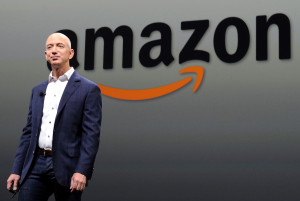The Cloud Wars Have Begun. Who Will Emerge Victorious?
 Ever since the advent of the Cloud concept, a slew of technology majors have been clawing their way upward, hoping to dominate what could soon be the most omnipresent component in the world of technology.
Ever since the advent of the Cloud concept, a slew of technology majors have been clawing their way upward, hoping to dominate what could soon be the most omnipresent component in the world of technology.
Why are they so eager to dominate the cloud space? What makes this business so appealing and attractive that practically every technology company worth its salt is vying for a shot at the top of this game?
The answer to these questions lies in the far-reaching influence of the cloud itself.
Google CEO Sundar Pichai confidently stated, recently:
“Every business in the world is going to run on cloud eventually.” – Sundar Pichai, CEO – Google
Now, I don’t know whether that prediction will ever prove prophetic, but one thing is for sure: the cloud will soon permeate every industry in the world from healthcare to professional services to manufacturing to practically any sector you care to name.
Now you can see why any technology company – or any company even vaguely connected with one of the many facets of cloud technology would want a piece of that pie.
The company that takes the lead in the next five years is very likely to dominate the space into the foreseeable future – and beyond.
I see three companies in contention for pole position in this space, and all three have already made significant progress in their respective cloud businesses.
Before we see who those companies are, let’s back up and cover the basics of cloud and its many forms.
What is “The Cloud”?
To describe what the cloud actually is, it’s necessary to use an analogy. What people refer to as “Cloud Computing” is essentially a combination of a technology infrastructure with a platform that hosts a variety of software applications. In the sense that the user doesn’t actually see any of this – merely accesses it from a remote location through a secure connection – the entire service is obscured, exactly the way a cloud would obscure your vision of the stars at night.
That’s the essence of the cloud. It’s a behind-the-scenes service that gives businesses access to powerful systems and resources without having to spend the extensive capital required to set up and own such a service.
Within the cloud are its resident elements, as shown in its simplest form in this diagram from Wikipedia:
New users would be surprised to know that they’ve already been using some form of cloud service for several years. Your Gmail account is hosted on Google’s servers, making it a cloud platform. When you shop on Amazon, you’re communicating with their servers through a cloud that is owned and operated by Amazon Web Services. If you’re a regular Facebook user, you’re accessing cloud inputs from a billion locations into Facebook’s cloud platform from across the globe every day.
The cloud is already all around us but it is so much a back-end support system that most of us don’t even realize that we’re been using it for so long.
How is it Segmented?
Over the years, the way the cloud was being used has created several intrinsic forms, such as:
- Infrastructure-as-a-Service (IaaS)
- Platform-as-a-Service (PaaS)
- Software-as-a-Service (SaaS)
- Business Process-as-a-Service (BPaaS)
If you go into specific offerings of every company operating a cloud service you may see further segmentation based on the purpose of the service and how customers see its value. For example, IBM offers Analytics-as-a-Service that gives users access to Watson, their analytics “brain” that is now handling billions upon billions of data points and cognitively interpreting that data into actionable information for healthcare providers and users from several diverse industries such as insurance and oil and gas.
To confuse things even more, companies use their own terminology, such as private/public or hybrid cloud, and most offer an overwhelmingly extensive range of solutions that target specific industries and verticals such as digital marketing, big data, game development, digital media and many more.
The Investor’s Scalpel
Thankfully, as an investor, you don’t need to know how the cloud works. The important thing for you is to see exactly who is making it work, and how. And you need to see that from a past-present-future perspective: as a combination of the technology backbone behind it, the hard current numbers they’re delivering now, and the solid future projections based on their individual growth strategies.
In no particular order, I’m going to outline what various companies have done with their cloud offering and how successful they’ve been. At the end, I will summarize my viewpoints and give you an actionable base of information that you can then act on.
Just like Watson!
So let’s get started…
Microsoft
 Azure is Microsoft’s cloud offering. It was officially launched on February 1, 2010 two years after the company announced it. It provides both IaaS and PaaS, with support for multiple programming languages, frameworks and systems that include Microsoft’s own software as well as integration with third-party systems.
Azure is Microsoft’s cloud offering. It was officially launched on February 1, 2010 two years after the company announced it. It provides both IaaS and PaaS, with support for multiple programming languages, frameworks and systems that include Microsoft’s own software as well as integration with third-party systems.
Microsoft reporting incomes from this segment as Intelligent Cloud; revenues in the six months ended December 2015 were in excess of $12 billion, putting the business at a potential $24-$25 billion a year.
Remember I mentioned that each company segments its cloud business differently from others? That’s exactly what you can see here: the total revenue includes income from server products, cloud services, Enterprise services and consulting. If you take out everything else, the Azure component – the one that provides the IaaS and PaaS offerings – brought in about $400 million during the final quarter of 2015, which ended in June 2015. That puts the “run rate” at about $1.6 billion for the year.
Amazon’s AWS

Amazon Web Services is by far the current market leader in the IaaS segment. With revenues topping $7 billion for the 2015 fiscal, the division is Amazon’s most profitable – growing revenues at double-digit percentages for a long time.
There are several unique things about AWS that are very different from the parent unit Amazon, which is primarily an e-commerce retail operator (or e-tailer, as they’re known.)
For one, while Amazon’s retail business is barely profitable, AWS tops the operating margin scales at a whopping 23.64% as of the last annual report. With margins like that, it may surprise you to know that they’ve already dropped their cloud service prices more than 50 times since they launched in 2006 – ten years ago.
From a business perspective, the best thing about Amazon Web Services is that it still has room to get into pricing wars with other tech companies for cloud dominance, which it has already achieved to a great degree.
IBM Cloud
 The grand-daddy of them all – IBM – is also a major player in the cloud business. They started experimenting with Virtual Machines (VMs) as early as the 1960s. The active decision to move into cloud services came in 2007.
The grand-daddy of them all – IBM – is also a major player in the cloud business. They started experimenting with Virtual Machines (VMs) as early as the 1960s. The active decision to move into cloud services came in 2007.
A key acquisition in the formation of IBM SmartCloud as a service offering came in 2013, when the company acquired SoftLayer and the division was christened IBM Cloud Services; or, simply, IBM Cloud.
The original estimate for cloud revenue for 2015 was $7 billion, according to a Forbes article published in January 2016. That figure came in at $10.2 billion for the year according to IBM’s annual report (full press release), an excerpt of which I have pasted below:
“- Total Cloud revenue of $10.2 billion up 57 percent adjusting for currency and the System x divestiture, up 43 percent as reported;
— Cloud delivered as a service revenues of $4.5 billion, up 61 percent adjusting for currency, up 50 percent as reported;
— Annual run rate of $5.3 billion vs. $3.5 billion in the fourth quarter 2014 for cloud delivered as a service;”
As you can see, the company is delivering well over par on expectations. However, stock prices are down based on a lukewarm outlook for 2016, which is expected to see a 10% drop in overall revenue, the prime driver of which is expected to be currency movements affecting their pre-tax profits to the tune of $1.3 billion.
 Unfortunately, Google doesn’t breakout its cloud earnings, but if it were a significant percentage of the top line they would have done that by now.
Unfortunately, Google doesn’t breakout its cloud earnings, but if it were a significant percentage of the top line they would have done that by now.
One point to note here is that Google’s current CEO, Sundar Pichai, was Product Chief before he took over the top job, while Microsoft promoted a Cloud and Enterprise expert to the position – Satya Nadella. This has resulted in different scenarios evolving for each company. While Google, under the parent company Alphabet is primarily a product and services company that offers its tools on its own cloud, Microsoft is focused on mobile and cloud services – as expressed by its “mobile first, cloud first” objective.
But things seem to be heating up in Google’s cloud business:
Of significance is the fact that Apple has reportedly signed up to Google’s cloud service while reducing its spend with AWS. In the past, Apple has used both AWS as well as Microsoft Azure as cloud providers. With an estimated spend of $1 billion on cloud-related services, this is one client that they can’t afford to ignore. Sources are yet to confirm whether the $400 to $600 million spend with Google is a spend cap or an annual rate.
Google seems to be getting really serious about its cloud business. It recently hired VMware co-founder and former CEO Diane Greene as head of its cloud business, and she has been on a roll negotiating deals and entering partnerships with companies like Spotify, which hosts some of its music on the AWS cloud platform.
Stealing clients from right under the nose of a rival is a sign of how cutthroat the competition and pricing wars are getting in the cloud, and how eager every company is to best its competitors and win over their business.
Word has it that Google and Verizon are also working on a Verizon hybrid cloud service running on the Google Cloud platform.
CSC
This one’s a silent but strong player in the cloud game. CSC BizCloud is their private cloud offering, and they also offer the CSC Agility Platform for hybrid cloud management. Like Google, CSC also does not break out its cloud income, but as of 3Q 2015, the company declared a 34% YoY growth in overall cloud revenue, while the commercial cloud pipeline was marked at $1.6 billion at a 19% YoY growth rate. Their global infrastructure services (GIS) unit reported $864 million in sales for the last quarter.
More recently, the company signed a 6-year agreement with the Metropolitan Police Service in London, UK, that’s estimated at almost £95 million ($135 million.) The deal includes IaaS, PaaS and SaaS, and will result in 20,000 tablets in the hands of law enforcement officers to help them complete their “paperwork” and other reporting at the crime scene instead of forcing them to head back to headquarters each time.
In North America, CSC has significant ties with government organizations like NASA, the IRS, the U.S. Army, the U.S. Department of Homeland Security and others. Many of these services are likely tied in to their cloud offering in one way or another, but since the company does not reports its cloud earnings as an individual line item, it’s impossible to break out.
Rackspace
Rackspace offers public, private and hybrid cloud solutions, as well as managed cloud services. Of note is the fact that they also offering cloud management for Azure, AWS and Office 365, essentially siphoning money from sales pipelines that Amazon and Microsoft has built, yet not impinging on the latter’s revenues.
This approach is part of its larger strategy of dealing with big players such as Amazon and Microsoft threatening to dominate the cloud service space. Rackspace’s sales pitch to the market that’s increasingly gravitating towards bigger companies is: “who’s going to manage that for you?” In a business where price cuts are the name of the game and aggressive pricing strategy is a powerful way to win customers, Rackspace has found a nice little niche for itself – to the tune of $421 million as of 1Q 2014, which has already grown tremendously over the past year and a half; Rackspace reported revenues of $532 million for 4Q 2015, with a growing portion starting to come in from their managed offerings.
Rackspace is now gradually leaning towards being the world’s number one provider of AWS cloud management services. In that regard, the company already has over 230 technical certifications for AWS and more than 1100 technical and business accreditations.
The Rest of the Pack
Behind the companies we have mentioned are emerging players like Alibaba’s Alicloud and Centurylink. Alicloud is targeting its home market of China and other Asian countries.
The Nutshell
In summary, the three biggest players to emerge as leaders in the cloud infrastructure segment are, in order of direct IaaS revenues, AWS with $8+ billion, IBM with $4.5+ billion and Microsoft with $1.5+ billion.
I strongly believe that Google’s new head of cloud will make sure that she positions Alphabet as the fourth significant name over the next few years, which are critical for all of these companies.
According to research data from Goldman Sachs, the cloud infrastructure market will grow at a healthy 19.2% rate for the next few years. Valued at only around $40 billion right now, at that estimate the opportunity will be twice this size by 2019.
Amazon is the clear leader for now, and has been for a long time. But with this kind of growth expected over the coming years, Microsoft, IBM and even Google have a shot at usurping their pole position.
At Microsoft, their focus is clearly on mobile and cloud, and this has positioned them to take the lead over IBM in terms of revenue from cloud infra services. In addition, the success of Office 365 puts additional pressure on Google as well as IBM to step up their game levels.
Meanwhile, Rackspace and CSC are silently moving in their own respective niches trying to gain cloud market share.
The cloud industry is big enough to support all of these companies, but it remains to be seen which one actually emerges as the clear and permanent leader over the next 3-5 years.
Will it be Amazon, which has already surged past the others? Will it be Microsoft, which has a cloud expert at the helm and a clear roadmap for cloud success? Or perhaps IBM, which has access to the largest Enterprise client base in the world? Or could it be Google that surprises us all after taking a bite of Apple from right under Amazon’s nose?
As an investor, you should be considering the positives and negatives of each company’s cloud presence and the niche they are hoping to dominate within that vast landscape.
Don’t just look at where they are now; look at what they’re doing, how they’re growing their client portfolios, what types of deals they’re striking, what innovative revenue streams they’re creating, what new cloud-based technologies they’re offering, what niche markets they’re approaching with their cloud offerings and so on.
If you’re a new investor in the cloud or technology segment, I hope I’ve been able to give you some insight into the current scenario. If you already own stocks in these companies, I urge you to watch this part of their business closely because it will be a major factor in their overall growth.
If you’re a cloud expert and would like to see articles on specific areas – or contribute to the site, please shoot an email to Shudeep@1reddrop.com and I will get back to you as soon as I possibly can.
Cheers!



